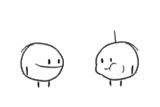as we know, today is earth day...yeah...the day we should appreciate our lovely earth...as we kow..there's a lot kind of pollutant had happened on our earth...the results are global warming and also green house...dont you guys realize that our days become hotter and hotter???
ouh ya!besides that, i had read on usa today...the astronomers said is pluto is the real planet...check this out!!!
The solar system is being downsized, and Pluto could get the pink slip.
The smallest and most distant planet is feeling the squeeze because scientists say they have clearer evidence of its size and origins.
"If Pluto were discovered today, it would not be classified as a planet," says University of Colorado astronomer Larry Esposito.
That's a slap in the face to traditionalist stargazers who say the nine-planet system we've hewed to for 66 years is still valid despite an avalanche of new theories spawned by high-tech exploration.
"There's just too much change. It's upsetting people," particularly schoolkids, says Clyde Tombaugh, who discovered Pluto the old-fashioned way in 1930 by eyeballing thousands of photos of specks in space.
Perhaps the only thing the two sides can agree on is that their dispute is now the most emotional and rancorous debate in astronomy today.
Pluto is an unlikely intellectual battlefield. About 3.7 billion miles from the Sun, the last planet to be discovered - and the only one claimed by an American - is so shrouded in mystery that its huge moon was only discovered in 1978.
A ball of rock, methane and nitrogen frozen to the hardness of steel, Pluto is just two-thirds the size of our Moon with only one-sixth its mass. At high noon, you can bask in its surface temperature of minus 446 degrees Farenheit.
How far away is 3.7 billion miles? If the Sun were a half-dollar coin placed on home plate at Yankee Stadium, a trip to Earth would be a 16-foot bunt back toward the pitcher. Pluto would be a 420-foot home run over the center field wall.
When discovered in 1930, Pluto was thought to be the majestic and mysterious "Planet X," several times larger than Earth. But now, the downsizers assert, it appears to be more like a cosmic dust bunny.
Their theory: A space immigrant from the wrong side of the solar system's border, Pluto was not spun off from solar matter like the other eight planets. It may be the remnants of a wayward comet that got sucked into the Sun's gravitational pull. Some astronomers think it's a "trans-Neptunian interloper," a lost moon of Neptune swept away by an unknown force.
The first Hubble Space Telescope photographs of Pluto's surface will be revealed Thursday, but experts say the images are probably too fuzzy to bolster either side.
"If we see a big sign that says, 'I am not a planet!' or find out that it is dog-shaped with floppy ears, at that time we could all get together and decide that it is not one of the nine planets," cracks David Levy, co-discoverer of the Shoemaker-Levy 9 comet that crashed into Jupiter in 1994.
The fight is trickling down to the USA's schools and libraries.
"I'm giving a talk at my 11-year-old son's school next month," says Harvard-Smithsonian astronomer Daniel Green. "I'm going to tell them that Pluto isn't a major planet."
But if Pluto isn't a planet or a moon, then what is it? Based on the latest observations, it could be classified as an asteroid.
The planet-asteroid controversy has made Green a target of the traditionalists because he's credited with firing the first salvo in the Great Pluto War.
In Sky & Telescope magazine, he argued that "Students are being greatly misled when told that Pluto is the ninth major planet. It is time to put Pluto into proper perspective as one of the many minor objects in the outer solar system."
Green now says that at least 20 astronomy textbooks refer to Pluto as something less than a major planet.
The latest edition of The Grand Tour, a solar system primer popular in school and public libraries, has already evolved to reflect that new worlds order.
Instead of lumping together the nine "traditional planets," The Grand Tour now divides the solar system into "The 15 largest worlds" and "Selected smaller worlds."
The Top 15 includes the first eight planets and seven moons, including ours. Pluto, alas, didn't make the cut.
"Planet status is really immaterial," says Ron Miller, who wrote and illustrated the book with William K. Hartmann.
But the planets and their "personalities" are a part of human culture that isn't easily changed, despite the ebb and flow of scientific theory.
We all had to memorize the names and order of the planets, we all built coathanger-and-thread mobiles with little Styrofoam planets circling a beach ball Sun.
There's the terrestrial planets: hot little Mercury, veiled Venus, our blue marble, and angry red Mars. Then the giants: Jupiter and its red spot, beautifully ringed Saturn, Uranus (the butt of sophomoric jokes) and vague Neptune. The caboose on this train is Pluto, the only planet with a Disney character.
These images are so ingrained that changing them will be a tough task.
The most powerful resister is the man whose life has been centered around Pluto: its discoverer, Tombaugh.
Scientists trying to demote Pluto "are just asking for trouble," says Tombaugh. "Another system is just too confusing."
Now, at age 90, he's still active, reading the latest scientific journals and devouring academic reports at his home near Las Cruces, N.M. He's concerned that a downgrading of Pluto's status could damage funding for research projects, such as NASA's Pluto Express, a proposed flyby of two spacecraft scheduled for launch in 2003.
"Pluto is far bigger than any asteroid," he says. "It's a real thing. We need to study it."
Besides, he says, "The kids want Pluto to be a planet. I get hundreds of letters. (Talk of demoting Pluto) makes them mad."
Comet-meister Levy agrees that tradition plays a role: "Several generations of people have grown up in a nine-planet world. To change just because a few people think that Pluto is too small, which it is not, or has a strange orbit - so what? - is just not a good enough reason."
Pluto's downsizing, if it comes to that, will be at the hands of the International Astronomical Union's Working Group for Planetary System Nomenclature, an international panel of space watchers whose job is to decide what to call things.
When Tombaugh found Pluto in 1930, the IAU group granted it planet status despite rumblings that it wasn't a major one.
Today, as the debate intensifies, the committee is sticking to its guns. Pluto may be losing the battle in some astronomy textbooks, but not here where counts.
"I'm pretty sure all the members would be against demoting Pluto in this way," says Kaare Aksnes, president of the panel and a professor at the Institute for Theoretical Astrophysics in Oslo, Norway.
Aksnes acknowledges that the latest data makes Pluto look less like a planet, "but we would do Pluto and Tombaugh an injustice and create confusion if we were to reclassify Pluto now. I believe that most people, be they astronomers or not, would agree."
http://www.usatoday.com/weather/wppluto.htm>source
lets love our earth ;))
by,
awien











0 kumint:
Post a Comment